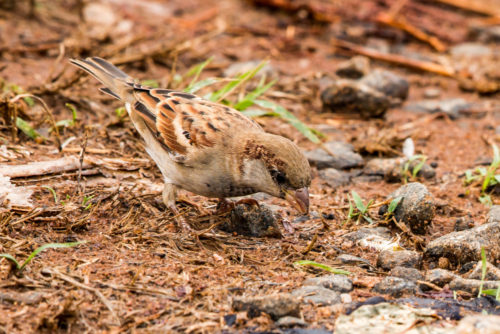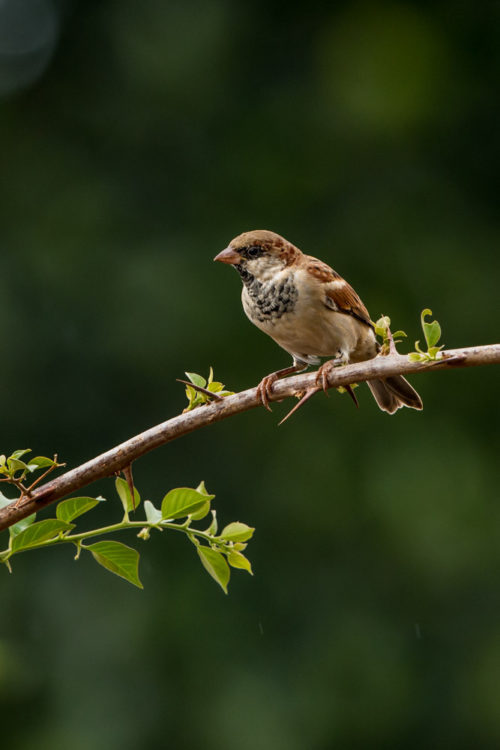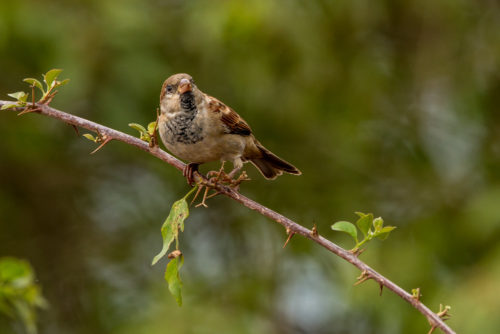
I found these house sparrows foraging for food in the local garden opposite Wayanad Heritage Museum, Ambalavayal. Last year when I had gone there, I captured them handheld using Canon EF 500mm f/4 L IS USM Lens fitted to Canon EOS 5DS R. It was drizzling. A small group of sparrows were trying to grab a quick meal before the rain disrupted their feeding. They were searching for grass seeds as well as Bougainvillea flower & seeds.

The House Sparrow (Passer domesticus) belongs to the sparrow family Passeridae. It is one of the most abundant birds with a substantial nexus with human settlements. House sparrows are originated in the Middle East and got introduced to most parts of the world. These introductions were successful because of its ability to adapt within human settlements quickly.

Males and females can be differentiated distinctly – the male have black throat white cheeks and black Bib while the female has brown colour with eye stripe and thick beak. The average size is 14-16 cms. And weight is nearly 26-32 grammes. Legs short. Chest unstreaked. Dust-bathing in new seedbeds is a common characteristic of House Sparrow. House sparrows prefer to make nests in small holes in buildings, thatched roofs and even street lamps. The combined chirping of the occupants is very familiar.

Ornithologist Salim Ali had labelled them as “man’s hanger-on” for they are known to enter homes nonchalantly, chattering non-stop as they set about arranging their personal living comfort by adding heaps of straw to any potential nest-site, quite unmindful of the householder’s presence.
Edward Hamilton Aitken from his book Common Birds of Bombay (1900) mentions of the strong streak of tenacity in sparrow’s character: “And when a Sparrow makes up its mind nothing will unmake it except the annihilation of that Sparrow. Its faithful spouse is always, and very strongly, of the same mind. So they set to work to make a hole in the corner of the ceiling-cloth, and they tear and tug with an energy which leaves no room for failure. Then they begin to fetch hay and the quantities which a couple will carry in a day is miraculous…. I declare solemnly that you might have fed a horse on the hay which I removed daily as most of it tumbled down….”

House sparrow has undergone a drastic decline in the past few decades. The present decline in house sparrow numbers appears to be widespread all over the world. The uncontrolled use of pesticides resulting in the absence of insects needed by young sparrow chicks is one of the primary reasons in declining population. Recently, World House Sparrow Day was announced and celebrating every year on March 20 to commemorate about sparrow population decline.

House sparrows have a social structure and are gregarious in all seasons with communal roosting. It shows different nesting habits usually prefer roofs of houses, crevices in buildings, holes in cliffs and banks, street lights, etc. It feeds on grains, seeds, the nectar of flowers, insects, etc. In urban surroundings, it feeds food crumbs left by humans. In all regions of the world, it shows limited migration. During breeding season it is seen in pairs or small groups otherwise it forms large flocks.The male house sparrow defends the nesting site aggressively during a breeding season. The male and female partner actively participate in rearing chicks. Normal lifespan is up to 12 years.
House Sparrows tend to forage for food on the ground, using a skipping movement when not in flight. Their flight is direct, with continued flapping and no periods of gliding. House Sparrows aggressively protect a small territory just around their nesting site. House Sparrows use a set of postures, behaviours and vocalisations to communicate, attract mates, deter intruders and warn others.

The decline in Houses sparrow population is found from a different part of the world for multiple reasons. The causes for the decrease of sparrow population are not scientifically proved, but several factors have attributed to their decline. Change in agriculture patterns and increased use of pesticides results in a decline in invertebrate prey. The decline in insect food severely affects the survival of young chicks. Poison residues from contaminated food grains also have devastating effects on sparrows. Sparrows prefer thatched houses and Bungalows for nest building. Modern trends in home construction reduced safe nesting places for sparrows. Hygienic practices of modern man in fear of bird droppings keeps away birds like sparrows from houses by fixing nets in the windows and ventilation.

The sparrows are forced to nest in open places which make it easy for predators to kill these birds. Hedges which provide shade and hiding places for birds are replaced by iron and concrete fences. Paved gardens in new houses without any mud keep away birds. Single variety grasses (Mexican grass) grown for beautification in gardens reduced a much native variety of grasses whose seeds were food for these birds. Modern means of transport resulted in an urban decline of the house sparrow as sparrows were deprived of leftover food grains in the roads. Moreover, the roads also became unsafe for them to feed. Now a day’s people aware of the decline of House Sparrow from urban and suburban areas initiated the movement of fixing human-made nests for them.

There has been a steep fall in House sparrow population that is about 75% since 1994 in London and studies shows a correlation between the disappearance of the sparrow and the introduction of Mobile phone towers. The electromagnetic radiation is proved to affect reproduction, circulatory and central nervous systems and may cause microwave syndrome which leads to declining general health. The criss-cross electric cables also do harm to them. Loss of birds increases the number of harmful insects like mosquitoes which are vectors of numerous pathogens.
Much like most bird species, the house sparrow is highly adaptable. Even though its traditional wilderness has been usurped and its living niche inside man’s once mud-and-thatch dwelling replaced with glass and concrete, the house sparrow could well be the last on this living planet. Humankind has to only spare just one hundredth of its cereal intake for the bird and make space for it around homes. By planting native hedges, and if there is no garden, by just providing nesting boxes, we can help Sparrow to populate again and live amongst us like good old times.


It’s such a wonderful Sparrows which disappeared due to stupidity of human technology, Which is hurting in every aspect.
It’s a grace to see such beautiful work from you. If i would have a dream to capture, I would like to capture like this on the wonderful Perch. Loved it.